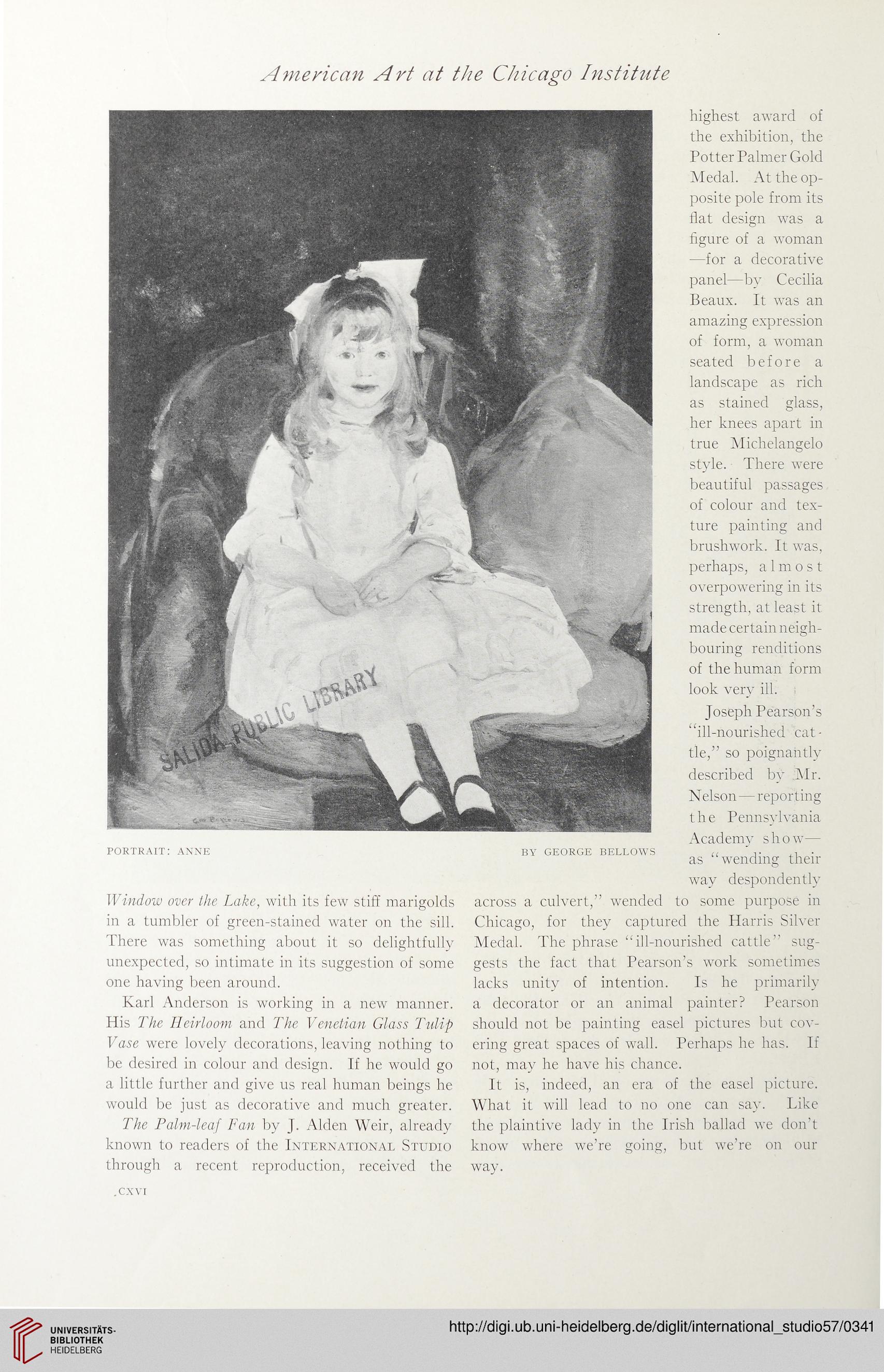American Art at the Chicago Institiite
PORTRAIT: ANNE
BY GEORGE BELLOWS
Window over the Lake, with its few stiff marigolds
in a tumbler of green-stained water on the sill.
There was something about it so delightfully
unexpected, so intimate in its suggestion of some
one having been around.
Karl Anderson is working in a new manner.
His The Heirloom and TZze Venetian Glass Tulip
Vase were lovely decorations, leaving nothing to
be desired in colour and design. If he would go
a little further and give us real human beings he
would be just as decorative and much greater.
The Palm-leaf Fan by J. Alden Weir, already
known to readers of the International Studio
through a recent reproduction, received the
highest award of
the exhibition, the
Potter Palmer Gold
Medal. At the op-
posite pole from its
flat design was a
figure of a woman
—for a decorative
panel—by Cecilia
Beaux. It was an
amazing expression
of form, a woman
seated before a
landscape as rich
as stained glass,
her knees apart in
true Michelangelo
style. There were
beautiful passages
of colour and tex-
ture painting and
brushwork. It was,
perhaps, almost
overpowering in its
strength, at least it
made certain neigh-
bouring renditions
of the human form
look very ill.
Joseph Pearson’s
“ill-nourished cat-
tle,” so poignantly
described by Air.
N elson—reporting
the Pennsylvania
Academy show—
as “wending their
way despondently
to some purpose in
across a culvert,” wended
Chicago, for they captured the Harris Silver
Medal. The phrase “ill-nourished cattle” sug-
gests the fact that Pearson’s work sometimes
lacks unity of intention. Is he primarily
a decorator or an animal painter? Pearson
should not be painting easel pictures but cov-
ering great spaces of wall. Perhaps he has. If
not, may he have his chance.
It is, indeed, an era of the easel picture.
What it will lead to no one can say. Like
the plaintive lady in the Irish ballad we don’t
know where we’re going, but we’re on our
way.
CXVI
PORTRAIT: ANNE
BY GEORGE BELLOWS
Window over the Lake, with its few stiff marigolds
in a tumbler of green-stained water on the sill.
There was something about it so delightfully
unexpected, so intimate in its suggestion of some
one having been around.
Karl Anderson is working in a new manner.
His The Heirloom and TZze Venetian Glass Tulip
Vase were lovely decorations, leaving nothing to
be desired in colour and design. If he would go
a little further and give us real human beings he
would be just as decorative and much greater.
The Palm-leaf Fan by J. Alden Weir, already
known to readers of the International Studio
through a recent reproduction, received the
highest award of
the exhibition, the
Potter Palmer Gold
Medal. At the op-
posite pole from its
flat design was a
figure of a woman
—for a decorative
panel—by Cecilia
Beaux. It was an
amazing expression
of form, a woman
seated before a
landscape as rich
as stained glass,
her knees apart in
true Michelangelo
style. There were
beautiful passages
of colour and tex-
ture painting and
brushwork. It was,
perhaps, almost
overpowering in its
strength, at least it
made certain neigh-
bouring renditions
of the human form
look very ill.
Joseph Pearson’s
“ill-nourished cat-
tle,” so poignantly
described by Air.
N elson—reporting
the Pennsylvania
Academy show—
as “wending their
way despondently
to some purpose in
across a culvert,” wended
Chicago, for they captured the Harris Silver
Medal. The phrase “ill-nourished cattle” sug-
gests the fact that Pearson’s work sometimes
lacks unity of intention. Is he primarily
a decorator or an animal painter? Pearson
should not be painting easel pictures but cov-
ering great spaces of wall. Perhaps he has. If
not, may he have his chance.
It is, indeed, an era of the easel picture.
What it will lead to no one can say. Like
the plaintive lady in the Irish ballad we don’t
know where we’re going, but we’re on our
way.
CXVI





